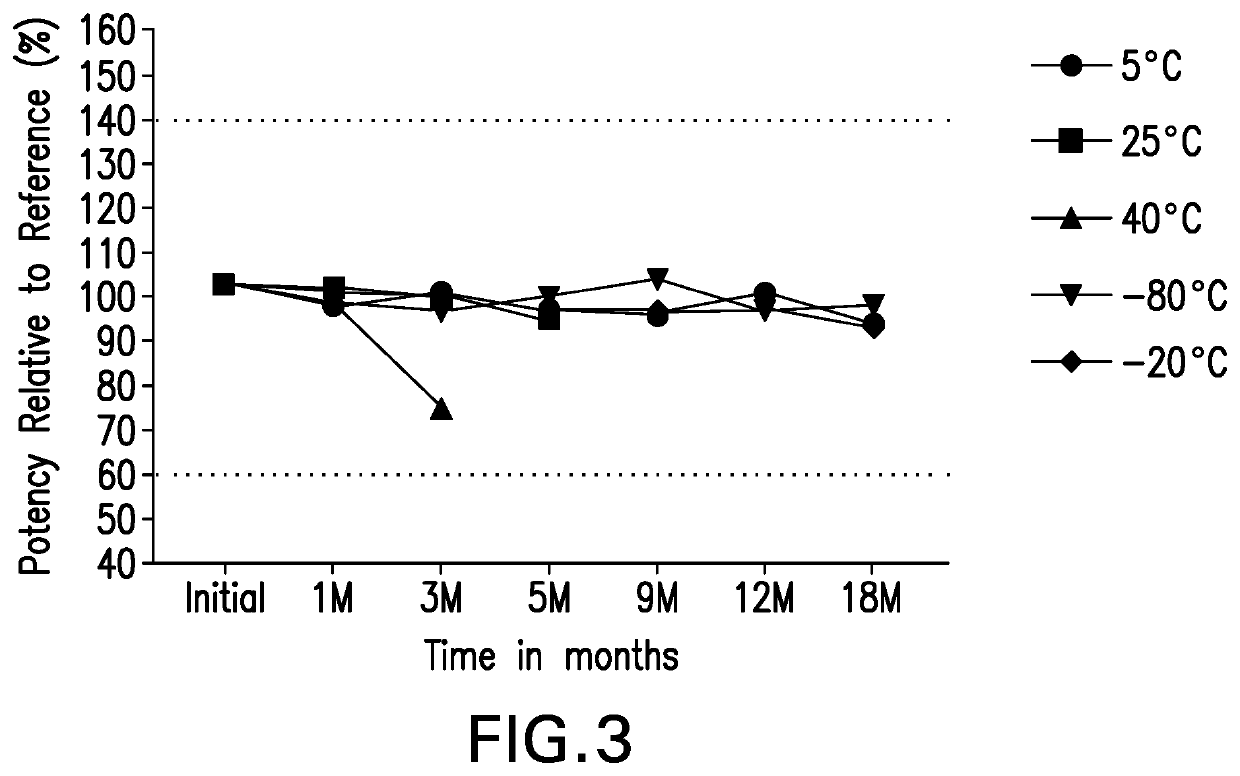Formulations of Anti-lag3 antibodies and co-formulations of Anti-lag3 antibodies and Anti-pd-1 antibodies
a technology of anti-lag3 antibodies and anti-pd-1 antibodies, which is applied in the field of therapeutic antibody forms, can solve the problems of inability to predict the solution conditions necessary, different responsiveness to the solution parameters, and different stabilitys in the solution, and achieve the effect of mitigate the phase separation of anti-lag3
- Summary
- Abstract
- Description
- Claims
- Application Information
AI Technical Summary
Benefits of technology
Problems solved by technology
Method used
Image
Examples
examples
Example: Long Term Stability Studies
[0260]The anti-LAG3 antibody (SEQ ID NOs: 35 and 57, light and heavy chains) was developed as either frozen drug product (recommended storage at ≤−70° C.) or refrigerated drug product (recommended storage at 2 to 8° C.) and stability studies were conducted in the below examples. Formulation A: 25 mg / mL anti-LAG3 antibody (SEQ ID NOs: 35 and 57, light and heavy chains); 50 mg / mL sucrose; 0.2 mg / mL polysorbate 80; 10 mM histidine buffer at pH 5.8; 70 mM L-Arginine-HCl. The frozen drug product is to be thawed at ambient room temperature prior to infusion. The drug product was packaged in a single-use, sterile 2 mL Type 1 glass tubing vial with a 13-mm elastomeric stopper and aluminum seal with plastic flip-off cap. Each vial contains a label claim of 50 mg (2.2 mL fill) at a concentration of 25 mg / mL.
[0261]The stability studies were conducted at −80° C.±10° C. (upright), at the accelerated storage condition of −20° C.±5° C. (upright), and at the stre...
example 2
te Matter Studies
[0262]Particulate matter data for the anti-LAG3 antibody in Formulation A was gathered using mHIAC, which is a modified version of the HIAC method, with a smaller sample volume. USP HIAC testing method has been used for detection of sub-visible particulates between 2 micron and 100 microns. Under a laminar flow hood, solution samples were allowed to come to room temperature, and then pooled gently into 50 mL polypropylene tubes to obtain a combined volume of at least 6 mL into a 50 mL polypropylene tube. The pooled samples were gently swirled and allowed to sit undisturbed for 30 minutes. Lyophilized samples were reconstituted with 2.2 mL Water for Injection, prior to pooling. Post reconstitution, samples were allowed to sit undisturbed under ambient conditions for 30 minutes prior to testing. Prior to sample analysis, the instrument was flushed five times with 0.22 micron filtered water by inserting the sampling probe tip nearly at the bottom of the 50 mL free sta...
example 3
y Binding ELISA
[0264]The potency assay assesses anti-LAG3 activity in Formulation A through anti-LAG3 binding to immobilized recombinant human LAG-3 (rhLAG-3). Dose response curves were generated by using serial dilutions of anti-LAG3 reference material and test samples. EC50 values, the concentration of anti-LAG3 reference material and test samples which exhibits 50% of the maximal binding, were determined using a four-parameter logistic curve fitting analysis. Relative potency was calculated by applying Parallel Line Analysis of dose-response curves in SoftMax® Pro. Potency of a test sample was reported as geometric mean potency relative to the reference material with a geometric standard deviation and 95% confidence interval.
[0265]Potency stability data at −80° C., −20° C., 5° C., 25° C. and 40° C. storage conditions for anti-LAG3 are shown in FIG. 3. There is no change observed in the results obtained to date and the data are within the acceptance criteria of 60%-140% potency re...
PUM
| Property | Measurement | Unit |
|---|---|---|
| concentration | aaaaa | aaaaa |
| concentration | aaaaa | aaaaa |
| pH | aaaaa | aaaaa |
Abstract
Description
Claims
Application Information
 Login to View More
Login to View More - R&D
- Intellectual Property
- Life Sciences
- Materials
- Tech Scout
- Unparalleled Data Quality
- Higher Quality Content
- 60% Fewer Hallucinations
Browse by: Latest US Patents, China's latest patents, Technical Efficacy Thesaurus, Application Domain, Technology Topic, Popular Technical Reports.
© 2025 PatSnap. All rights reserved.Legal|Privacy policy|Modern Slavery Act Transparency Statement|Sitemap|About US| Contact US: help@patsnap.com



